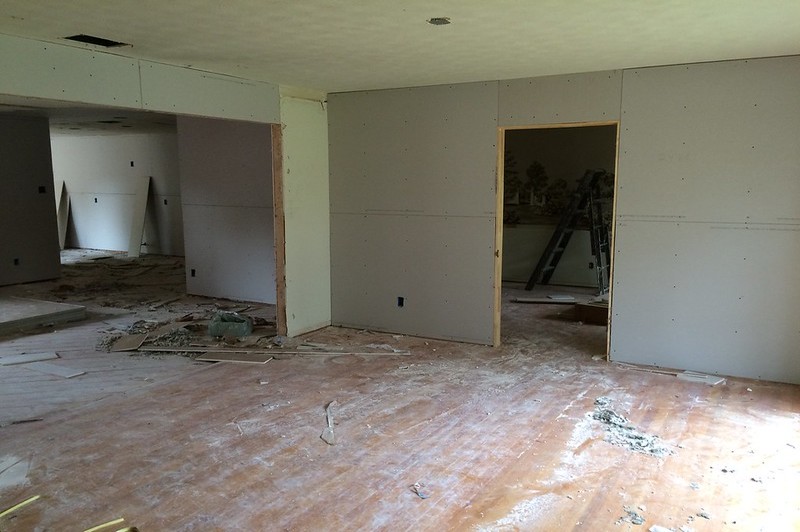Knowing what does water damaged drywall looks like helps you identify early signs and manage them before deterioration spreads. After a heavy storm or if you suspect a pipe leaking behind drywall, it’s best to learn what to do and assess it; continue reading to know more about this.

Defining Drywall
Drywall is a building material made from multiple components such as wood fiber, asbestos-cement boards, and gypsum. It may provide a resistant factor against water, fire, sound, mold, and mildew.
It is a practical product that is easy to lodge. Some common causes of drywall damage are furniture scuffs, holes, water damage, cracks, joint tape loosened, dented corners, and termites.
But among those, we would be discussing water damage here. Water damages can be caused by broken water pipes, floods, and storms.
If water damages weren’t immediately addressed, the drywall might weaken, caved in, and become a perfect growing place for mold or mildew. The longer water soaked it, the harder it was to save.
Signs Of Water Damage
It can be pretty expensive to repair damages caused by water on drywalls; hence, it is best to spend time preventing this from happening. You can start by educating yourself, which you are already doing.
Other than knowing what drywall is, you can also learn what causes damage to it and familiarize yourself with the signs of wear.
Even though prevention is the preferable approach, there’s a limit to how you can prevent water damage. It can also be challenging unless you have a way to monitor when water pipes leak behind the drywall or can deflect storms.
What you can do is increase the chances of it being able to resist water. One can do this by waterproofing drywall; learn all the information, including the process here on waterproofing drywall.
On the other hand, you may start comprehending these signs of water damaged drywall:
- Softened drywall, when soaked too much, the inside may get affected even when outside still looks alright. So it’s best to check on this; do it by pushing on the suspected affected area, and if it bends, it might be damaged.
- Bubbling or cracking paint may also point to water damage. Water accumulated inside by drywall may get to the paint, stretch it, and fill it like a bubble.
- Discoloration of paint on drywall may occur; smudges running down might be shown. Hence, this is an excellent point to remember.
- Mold or mildew growth may also indicate water-damaged drywall. Mold and mildew love moisture; there is a high probability of them growing in moist places.
You may also visit this article about how long does it take for mold to grow on drywall if you are interested in knowing more about the fourth sign.
Repairing water-damaged drywall
After detecting the drywall damaged by water, it is now time for repairs. You may do it by yourself if you have prior knowledge and confidence to complete the task; if not, you may also call for a professional to do these tasks.
Determine the degree of the damage on drywall by visiting this article concerning what happens when drywall gets wet.
There may be a case where you won’t need to replace your drywall, and others only need to dry it out. Follow the step-by-step instructions below, and this goes well with relatively new water damage:
Step #1. Know the cause
The first step involves knowing the cause. The cause can be a storm that just passed by, a water pipe damage that is leaking behind the drywall, or an appliance causing it.
You may use a moisture meter if you want an accurate assessment if the water-damaged drywall’s source was from the inside.
Step #2. Professional dehumidifier
You’ll need a professional dehumidifier for this next step. If you don’t have one, you may rent it from local stores; no need to buy one if you wouldn’t have to use it, and renting is far cheaper.
Besides the dehumidifier, you would also need to rent a high-volume fan.
Step #3. Setting equipment up
Close the window before the equipment starts operating.
Ensure that you place the dehumidifier near the accumulation of water. Then position the fan where it can help guide water towards the dehumidifier.
After that would be a long wait depending on how much water accumulation there is. Occasionally, you would have to see if the dehumidifier is filled or if the moisture level has already decreased.
Step #4. There are two paths for the last step
If you successfully decreased the moisture content on the drywall, you may now proceed to coat it with primer, then paint.
However, if the moisture content continues not to decrease, there may have been an underlying problem that you would still need to resolve, like maybe the water pipe was still leaking inside. You may have to ask for a professional’s help for this.
If you found the water damage on drywall only after the problem is already worse, then you might proceed to replace the drywall. You can also read about how to detect water damaged wood for further information.
Conclusion
Water-damaged drywall can get messy and expensive to repair. It’s essential to know what does water damaged drywall looks like, so you can act immediately upon sighting its first signs.
Hopefully, this article was able to help enlighten you regarding this subject. Always remember to proceed with caution when tackling this, though.
